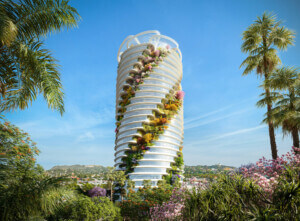Architects Declare was supposed to have sounded a clarion on climate change upon its founding, when 17 major U.K.-based firms, including Foster + Partners, Zaha Hadid Architects, David Chipperfield Architects, Rogers Stirk Harbour + Partners, and more declared a state of emergency in June 2019. Since then, hundreds of firms across more than 20 countries have signed on to the pledge, which tasked firms with mitigating climate change and heading off ecological disaster by reorganizing the way they work.
Now Foster + Partners has withdrawn, and the organization is embroiled in a tiff with Patrik Schumacher after his comments that radical action on climate change and economic growth were incompatible.
In the case of Foster + Partners’ withdrawal from the coalition this morning, the cause was quite simple: The group had called on its member firms (now over 1,000 strong in the U.K.) to reaffirm that they wouldn’t keep working under a “business as usual” praxis, and that included designing airports. According to the Architects’ Journal, Foster + Partners had come under fire from the group over the summer after revealing their most recent international airport for Saudi Arabia, a year after France’s environmental agency flagged the firm’s Marseilles Airport extension for the same reason—encouraging more air travel, and more emissions.
However, Foster + Partners seemingly disagrees that designing new airports is at odds with reducing emissions and that planes powered by renewables could be available as soon as 2035. The firm also released the following statement to AN, signed by Norman Foster:
Foster + Partners has withdrawn from Architects Declare because, since our founding in 1967, we have pioneered a green agenda and believe that aviation, like any other sector, needs the most sustainable infrastructure to fulfil its purpose. Unlike Architects Declare we are committed to address that need.
We believe that the hallmark of our age, and the future of our globally connected world, is mobility. Mobility of people, goods and information across boundaries. Only by internationally coordinated action can we confront the issues of global warming and, indeed, future pandemics. Aviation has a vital role to play in this process and will continue to do so. You cannot wind the clock backwards.
At the end of the last century, we reinvented the airport terminal to humanise it with natural light, and significantly reduce its carbon footprint. This is in a tradition going back to the nineteen sixties when we were advocating a green architecture before it was so named. We pioneered low energy design concepts, the harvesting of water, the recycling of human waste into fertiliser, and renewable energy technologies such as solar arrays and wind turbines. That sustainability agenda has been developed over decades of professional practice with many realised examples such as Berlin’s Reichstag as a manifesto of clean energy, and the experiments of the Masdar Institute as a solar powered university community in the desert. We designed the first LEED Gold rated building in Manhattan, the Hearst Tower, which was so ahead of its time in terms of performance that LEED created a new Platinum rating for that building. Since then, projects for Apple in California and Bloomberg in London, have pushed the boundaries further in terms of health and sustainability in the workplace. The latter achieved the highest ever BREEAM rating for sustainability.
Returning to aviation, we created the Queen Alia Airport in Jordan which, through a combination of good design and operational management, became, in 2018, the first Airport in Middle East to receive ACI Level 3+ Carbon Neutrality. We also believe that the airliners that serve terminals such as Queen Alia will continue their present trajectory of going further, more safely and more quietly, with less fuel and further reductions in carbon footprint. The creation of non-fossil fuel alternatives is already a reality and implementation of these new technologies would require no change to existing aircraft fleets. Airbus recently released three concept planes that would be powered by hydrogen rather than jet fuel and which, they claim, could be carrying passengers by 2035.
Meanwhile, whilst our industry and others continue to drive these positive changes through innovation rather than protest, a sense of proportion and serious consideration of the facts is required. This could start with the realisation that emissions from jets are estimated to account for only 2% of all greenhouse gas emissions compared with 14% from other forms of transport. Animals and agriculture account for 15%. To put it simply, emissions from the production of hamburgers, steaks and similar products is about the same as everything that moves mechanically on the planet — cars, trucks, trains, ships — and aircraft. If carbon imprints are properly taxed, then it may mean a reset for fast food and cheap flights but agriculture and aviation are not going to go away and they will both need the most sustainable buildings to serve them together with the architects who can most responsibly design them.
For these reasons, Foster + Partners has withdrawn from Architects Declare and Engineers Declare.
However, it’s important to note that the planes cited by Foster + Partners as viable, zero-carbon alternatives are still prototypes, and as the AJ pointed out, one percent of the world’s population is responsible for half of the emissions produced by the air travel sector. Additionally, according to a New York Times report, even with planes becoming more fuel-efficient, demand has been increasing so much that emissions from flying are growing “worse than anyone expected” to “dire” levels.











